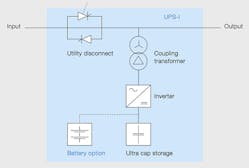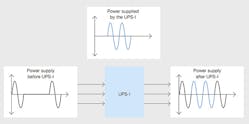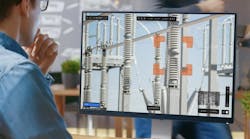ABB's UPS-I is a new generation, line-interactive power protection product that protects customers' loads during outages and major voltage disturbances. Such events can be caused by faults in the electricity network and, more commonly, weather events such as lightning.
The UPS-I is a particularly good solution for recloser events, deep voltage sags (dips) or swells and it supports critical loads until the utility voltage returns to within specification or a standby generator starts. The length of the backup time is dependent on the power requirement of the load and the capacity of the storage system. The UPS-I range has models up to 2.4 MVA at low voltage, making it suitable for even large industrial processes. The energy storage medium itself can be state-of-the-art ultracapacitor modules or lead acid batteries.
What is revolutionary about the UPS-I?
The three main innovations around the UPS-I are:
- High efficiency
- Fast utility disconnect
- Revolutionary storage
High efficiency
The ABB UPS-I has an efficiency of greater than 99 percent for all 380 to 480 V models and greater than 98 percent for 208 and 200 Volt models.
This is revolutionary in the industry as legacy solutions typically exhibit 92 to 95 percent efficiency at full load and this percentage decreases with reduced load. The UPS-I has a minimal drop in efficiency down to 25 percent load.
The high efficiency of the UPS-I stems from its "offline" design. In normal operation, the inverters and coupling transformer are ready but are not carrying any load current; the only component carrying the load current is the utility disconnect, a high-efficiency SCR (silicon-controlled rectifier) switch. In the legacy double-conversion UPS system design, the rectifier and inverter are carrying and converting the entire load current, which has a major impact on the efficiency. From the beginning, the UPS-I design concept was to maximize efficiency by moving beyond traditional design concepts.
Fast utility disconnect
Silicon-controlled rectifiers (SCRs) are used in the UPS-I to disconnect the load from the utility during a power quality event. It is a known characteristic of these rugged, high-power switching semiconductors that removing the gate drive voltage is not always sufficient to turn off the device as the device current must reduce to zero. The UPS-I actively commutates the SCRs by using the inverters to inject current when a power quality event is detected, thus forcing the SCR current to zero.
1 UPS-I: single-line diagram
Revolutionary storage
Battery and ultracapacitor storage options are available for the UPS-I product ➔ 1. Although batteries have been around for a long time, the UPS-I is designed to operate with the latest low impedance spiral-wound sealed lead acid batteries, which provide very high energy density and have only a small system footprint.
The batteries for a 30 s 2.4 MVA system take up only eight 800mm2 square storage enclosures – an unprecedented compactness.
The ultracapacitor storage option is ideal for high-reliability applications where short duration backup is required (typically 3 s). Ultracapacitors have exceptionally low impedance, which means an even higher energy density and reduced footprint. The life span is up to 15 years and a 2.4 MVA system will require only four 800mm2 square storage enclosures.
Redundant operation
The UPS-I uses a redundant array of modular inverter systems that are capable of operation at reduced power with up to 50 percent of modules unavailable. The inverter redundancy and the very short time required to replace a faulty module combine to provide an extremely high level of system availability.
CAPEX and OPEX comparison
The UPS-I typically requires less than a quarter of the footprint of a legacy UPS, which equates to significant savings in upfront building costs, with savings continuing throughout the operating life of the system. It also requires about an eighth of the air-conditioning of a legacy system, thus massively reducing greenhouse gas production.
3 A short-duration power outage event
Event example
A short-duration power outage event is shown in ➔ 3. The UPS-I will detect the event as it polls the input voltage on a 125 μs cycle, comparing the result with expected utility voltage vectors. The decision to transfer to storage is made based on two thresholds: RMS detection and fast transient detection. This method provides fast detection while minimizing any false triggers. Upon detection of the event the UPS-I disconnects the utility by rapidly opening a semiconductor switch connected in series with the load and then supplying the load from its storage (ultracapacitors or batteries). This utility disconnection and changeover typically occurs in 2 to 4 ms, which is less than a quarter of a mains cycle, so there is no load disruption. When the utility returns to within specification the UPS-I will resynchronize before waiting 100 ms to ensure the utility is stable before returning to normal operation. The system then quickly recharges its storage media to ensure maximum backup time is available for any future power-quality events.
|
2 Increasing capacity Ultracapacitors, also called super capacitors or double-layer capacitors, were first developed in 1957, though it was another 20 years before any significant commercialization of the technology took place. Indeed, in the intervening years, the underlying science was almost forgotten and then “rediscovered.” In the mid-1990s advances in materials and refinement of the existing systems led to improved performance and reduced costs. This development has allowed ultracapacitors to compete with existing technologies, such as electrolytic capacitors and flywheels, and batteries in certain applications. The batteries used in the UPS-I are a refinement of existing technology. The batteries incorporate a spiral plate design that allows a very low cell resistance, so they are capable of providing large amounts of current for a short time, making them ideal for short-term storage requirements. |
UPS-I in operation
The innovative features of the UPS-I ➔ 2 were highlighted by a project to stabilize the power supply for one of Malaysia's largest and longest-established manufacturers of semiconductor products. As a high-tech company, they employ sophisticated equipment and this tends to be very sensitive to instabilities in the power supply. They have continually been confronted with loss of production and revenue caused by power fluctuations. Losses can be as high as the cost of resuming operations, and scrapping damaged products can amount to millions of dollars. Six 900 kVA UPS-I units were supplied and installed, and these successfully eliminated voltage disturbances, resulting in a disruption-free production process.
There have been many UPS-I projects and customers in South Korea, Switzerland, Sweden and the United States. The prototype was installed in 2008 and the first project of four 300 kVA units was sold to South Korea in 2009. The product is employed in carbon fiber manufacturing in the aerospace industry, data centers, cable manufacturing, semiconductor fabs, and food and beverage and high-speed packaging operations.
Over seventy 1500 kVA systems have been supplied to the semiconductor industry in Asia alone. In Europe, the UPS-I is generating significant new business in the data center market and in general industry.
The UPS-I has been well received and accepted for its performance in the semiconductor market. It has already supported many of the world's largest memory and flat-panel-display companies in delivering continuous power performance and reliability while having minimal environmental impact.
The product's strengths are its efficiency, reliability, life span, small footprint and high power rating in a single UPS system (up to 2.4 MW). User benefits are: protection against short outages as well as deep sags; backup during generator start-up following a utility supply failure; and allowing process loads to ride through common power problems leading to increased yield, reduced product wastage and increased productivity.
The benefits of the UPS-I outclass other offerings available on the market and with continuous improvement it will meet an ever-increasing appetite of customer demands.
Sophie Benson-Warner
ABB Discrete Automation and Motion, LV Power Converter Products
Napier, New Zealand
[email protected]




